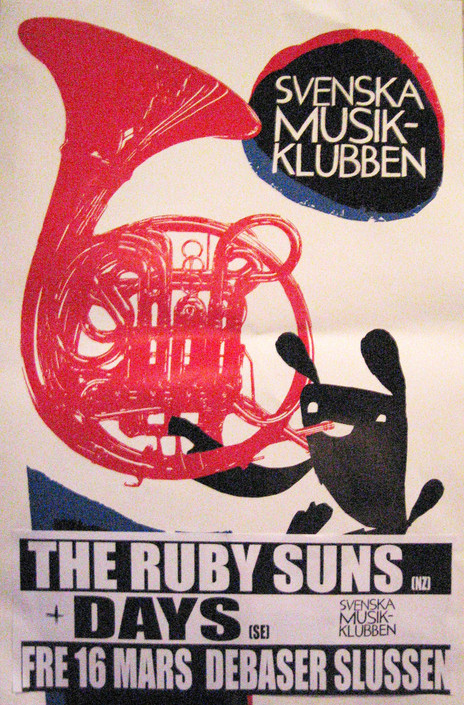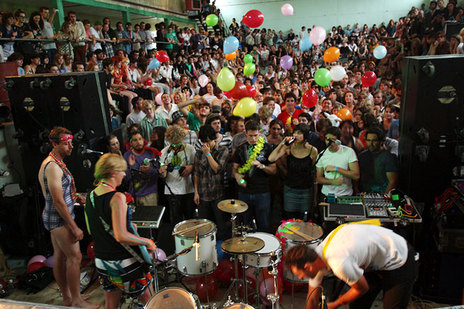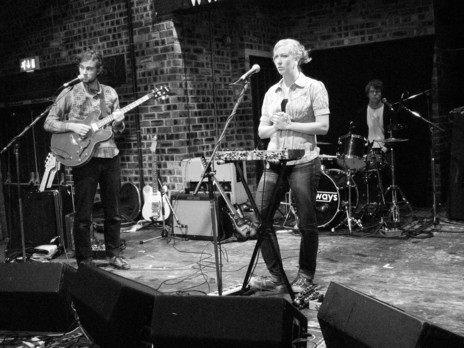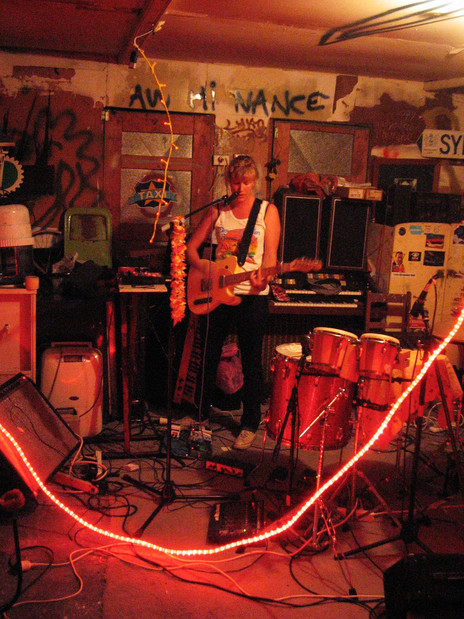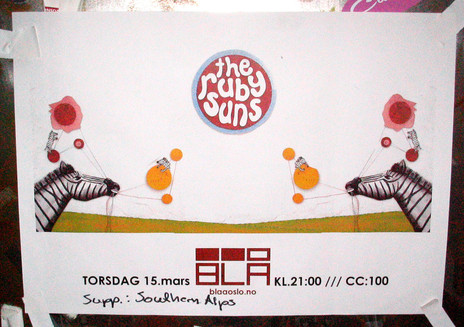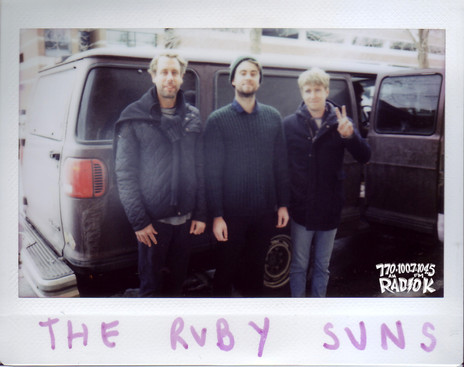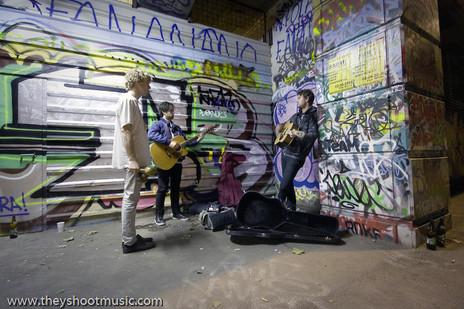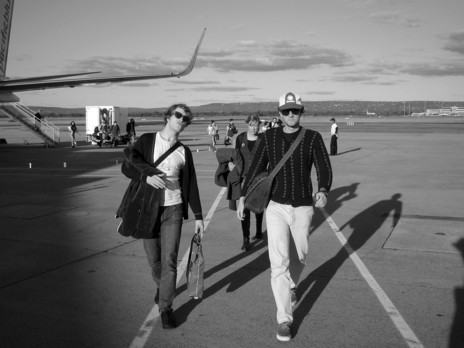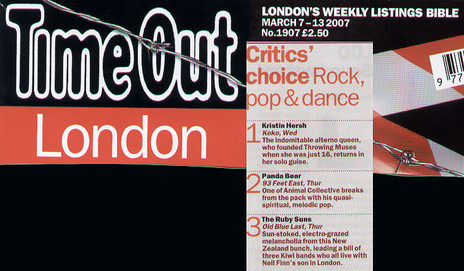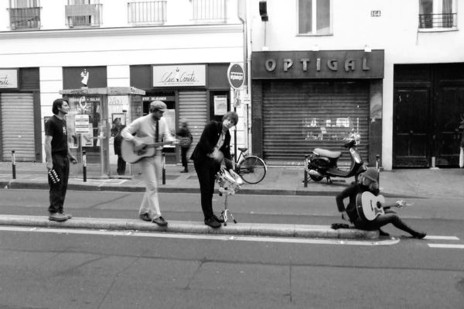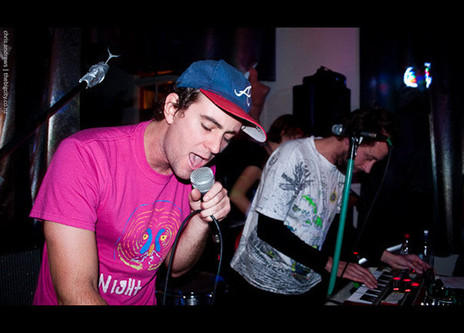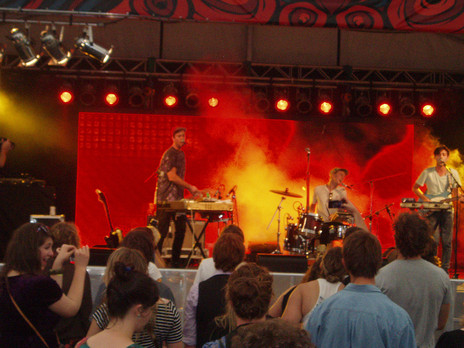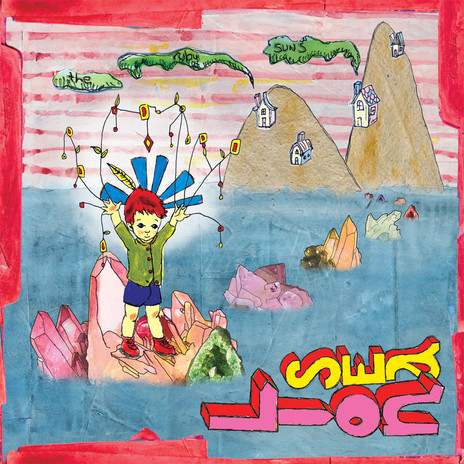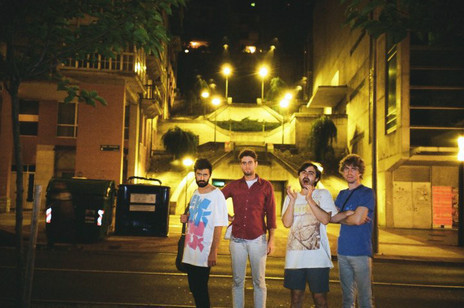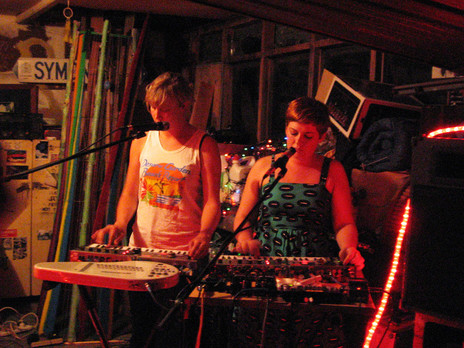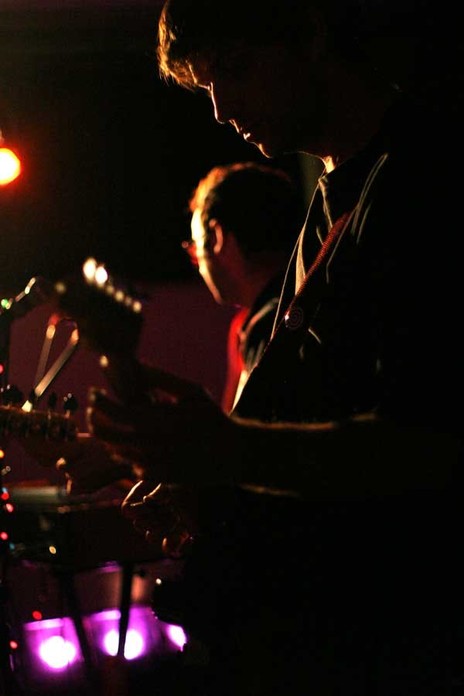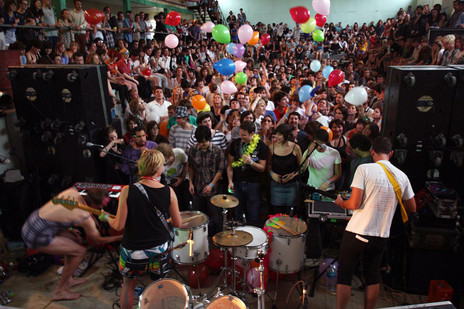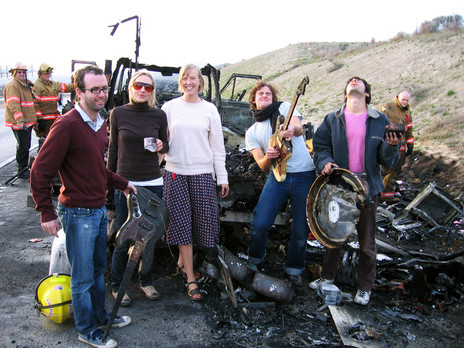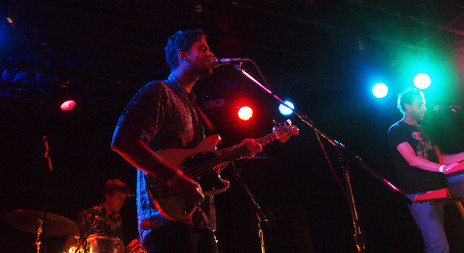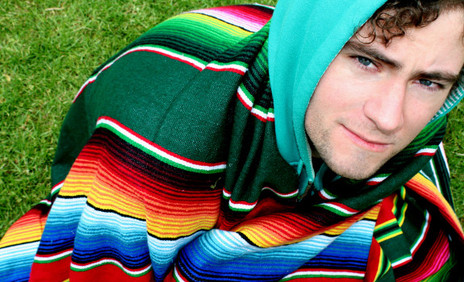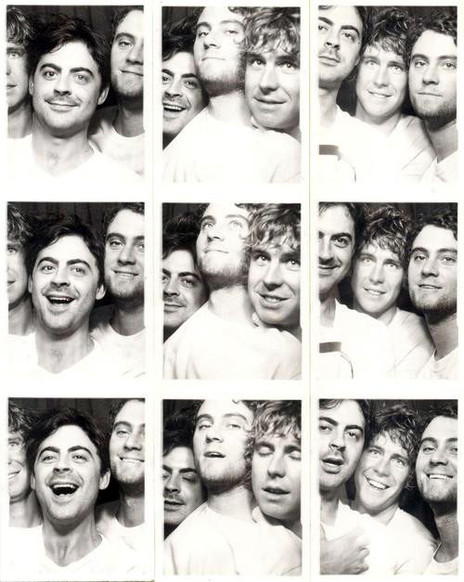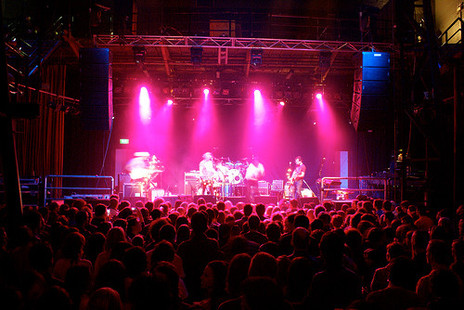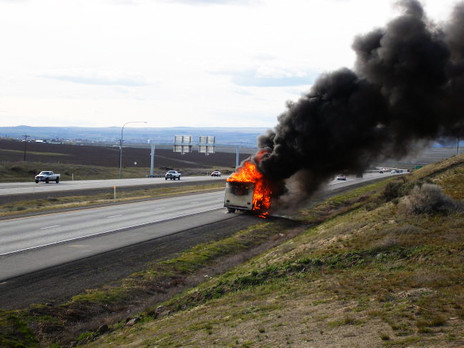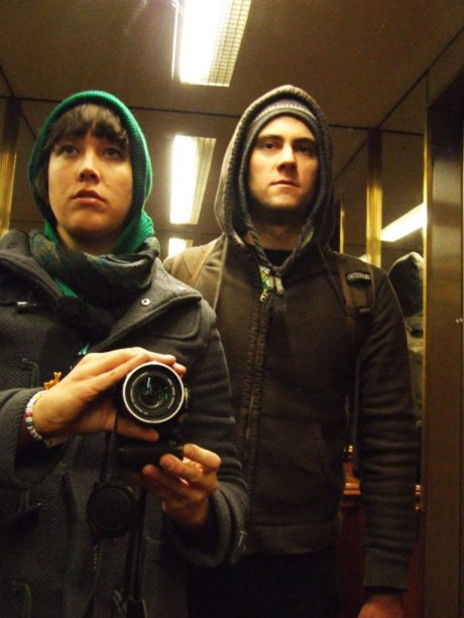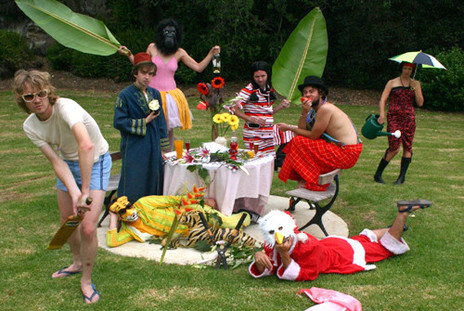Ryan McPhun’s music career in New Zealand was kickstarted by a sudden call to join indie group The Brunettes. The band had booked an Australian tour, but their drummer quit suddenly, leaving McPhun four days to learn their full set before flying out.
At this point I have to impose myself on the story, since my own brief spell in The Ruby Suns started when he got back. I was in the Tokey Tones with Scott Mannion and both of us offered to join McPhun’s new band, along with Mark Stebben (from Leonard). It was this fledgling line-up did the band’s first gig, playing support for The Brunettes at Leigh Sawmill.
McPhun soon decided it would be easier to have his then-girlfriend, Amee Robinson, on keyboards – even though she’d never played them before. He also convinced fellow Brunette, James Milne (aka Lawrence Arabia) to join on drums, despite his limited familiarity with the instrument. Robinson could play saxophone a little bit, so that got thrown into the mix too, along with Harry Cundy (from The Brunettes) on trumpet.
At first, we played as “Ryan McPhun and The Ruby Suns” but having a long band name with an internal rhyme and doing songs with glockenspiels and hand-claps possibly obscured the more interesting elements of the music (and Ryan’s Californian accent solidified the oft-repeated Beach Boys comparisons). The band’s 2005 self-titled album still had many standout tracks, such as the psychedelic ‘Sleep In The Garden’ and mini-epic ‘Ten Years On Autopilot’.
McPhun also played in Milnes’ group, The Reduction Agents, plus the pair of them joined with Scott and Jonathan Bree (The Brunettes) to form the Disciples of Macca, a covers band that only played Paul McCartney solo material.
The first breakthrough for The Ruby Suns arrived via Lawrence Mikkelsen, one of the original co-founders of Lil Chief.
In 2005, The Brunettes supported The Shins for a New Zealand tour. Jonathan Bree invited them over for a party at his ramshackle Kingsland flat (a place he shared with Scott Mannion, which they used to run their label – aka the Lil Chief ghetto). The Ruby Suns played a set, hoping to impress The Shins and the visiting owner of their label (Jonathan Poneman from Sub Pop), but we were rigid with nerves and a few too many beers to the wind to play well. Marty from The Shins was kind enough to stay in the room, but the rest of the band slunk off to a bedroom. At least they left with a copy of The Ruby Suns’ first album in hand. The Brunettes did a better job of getting noticed and were invited to tour the US with The Shins, taking McPhun, Milne and Robinson with them.
Robinson had been playing in a band for less than a year and suddenly found herself in front of audiences of 3,000 people. “To be honest it felt like I was a faker. I never really developed a ‘feel’ for playing keyboard and I largely despised the saxophone. Instead I realised that what I could offer The Brunettes and The Ruby Suns was my ability to memorise parts and multi-task – two very handy skills for those bands at that time, when one was expected to play a vast array of noise making gadgets including melodica, glockenspiel, drums, hand-claps, bike bells, a space-echo machine, and so on.”
The first breakthrough for The Ruby Suns arrived via Lawrence Mikkelsen, one of the original co-founders of Lil Chief (though he ended up volunteering his time rather than becoming a financial partner). He’d given the Ruby Suns CD to a friend, Liz Bradley, who had written about it on her blog, comparing it to UK group, Field Music. One of the co-owners of Field Music’s label, Memphis Industries, read the post and got in touch about signing The Ruby Suns. Handy timing, as Memphis had just had a big hit in London with the debut album by the Go! Team.
Adventure Tour
McPhun and Robinson were buzzing after The Brunettes’ US tour and were impatient to get the Ruby Suns overseas. However James Milne and I weren’t available – he’d quit to focus on his Lawrence Arabia work and I was booked to talk at the Wellington Arts Festival. Instead the band enlisted James Dansey (from The Sneaks) and James’ girlfriend at the time, Olivia Kember (a journalist) to form a new line-up for the tour (along with stalwart, Mark Stebben). Robinson booked the band an 18 date tour of the US (including a slot at SXSW) and they borrowed some money to purchase an old motorhome that served as both tour van and accommodation.
Driving on the motorway en route to Seattle, McPhun was was flagged over by a passing motorist and saw flames blasting out of the RV’s exhaust. Robinson recalls the fire spread quickly:
“It took maybe ten minutes for the motorhome to become a massive inferno with a few explosions to boot. In hindsight there was probably enough time to get a few items out, but no one knew when the gas tank or propane tank would blow, so we just watched it go. I actually walked off down the highway verge in a kind of trance, then lay in some grass, while miles and miles of people in cars backed up behind the motorhome, yelling from their car windows, asking if I was okay. I remember lying there looking up at the blue sky, feeling like I was floating and really buzzing out on being alive, then some firefighter heads with big gas mask things on popped into my view and snapped me out of it. I guess I had gone into a state of shock. We lost everything, except what we had in our pockets. Within the first six months of being back in New Zealand from that tour, I called the fire department quite a lot about fires that weren’t really fires. So yeah, the motorhome fire was traumatic.”
Fortunately, one of the firefighters turned out to be a New Zealander; he gave them a place to stay that night and arranged for them to play a fundraiser show at his church, where the band received donated clothes and enough money to complete the tour. (Read After The Fire here)
It was fascinating to see the first Ruby Suns album, which had received such average reviews at home, suddenly being lauded in the UK press.
The Ruby Suns’ next overseas tour was in support of the UK release of the first album in 2007. McPhun trimmed the band down to a four-piece to save on expenses, so unfortunately Mark Stebben was left behind. The drummer at that time was Edward Castelow, who was just starting up Dictaphone Blues (Ryan and I played in an early version of the band). The tour began with a run of support slots throughout the UK with Field Music (a friendly band, with an audience who were very supportive of us) and the Ruby Suns were listed as co-headliners for a packed show at the ICA in London. But then our booking agent had us do another leg with young band-of-the-moment, the Holloways. Every hip group in London at the time wanted to sound like Pete Doherty and they were no exception. They travelled in a full scale touring bus, while we trailed them around the country in a minivan, selling less merch than we had at the Field Music shows, despite the large sold-out venues.
It was fascinating to see the first Ruby Suns album, which had received such average reviews at home, suddenly being lauded in the UK press. The Guardian called it “Remarkable” (4 stars out of 5), The Sun said it was “harmonic genius” (4.5 stars out of 5), Uncut described it as “sparkling multilayered sunshine pop” (4 stars out of 5) and Mojo proclaimed it was “astonishingly good” (4 stars out of 5).
Back at home, Mark Stebben rejoined us and we undertook a large-scale Australasian tour supporting The Shins. During the final show at the Enmore in Sydney, we drunkenly rushed the stage during their encore and Ryan took over the guitar solo while I hoisted bass player Marty onto my shoulders, much to the horror of their tour manager, who was no doubt keenly aware of how much it would cost the band if Marty was injured.
Kenya Dig It?
The Ruby Suns second album, Sea Lion (2008), came out through Sub Pop in the US/Asia, Memphis Industries in the UK/Europe, Pop Frenzy in Australia, and Lil Chief in New Zealand. McPhun’s music was growing ever more interesting, as he threw more and more elements into the mix – African drum patterns and finger pianos (mbira), lyrics in te reo (‘Tane Mahuta’) and Spanish (‘Oh Mojave’), and an autoharp hit to sound like cimbalom (‘It’s Mwangi In Front Of Me’). Pitchfork named it as one of the “best new albums” (giving 8.3/10), Drowned in Sound gave it 8/10, and Uncut again gave the band four stars. This gave The Ruby Suns a footing in the worldwide indie scene and album sales in the US alone soon surpassed 8,000 (with thousands more in other territories).
In late 2007, McPhun decided to trim his touring line-up even further, rearranging the band as a three-piece with the addition of multi-instrumentalist, Imogen Taylor (she had previously backed Jens Lekmen for one of his NZ tours and was the key force behind Eden’s Bar regulars, Musche Musche). McPhun brought the drums out front in a standing set-up and recorded live loops of drumbeats with a pedal, so he could switch to guitar when necessary. This brought his percussive drum style to the fore and the band recruited James Dansey as soundman to make sure full scope of their sound still reached their audience.
Nonetheless, McPhun admits occasionally feeling constrained by the new line-up: “Ideally we would’ve had multiple percussionists and at least one person each on guitar, bass and synth, but for monetary reasons that was impossible. Though I was excited to bring electronic elements into the live set, it was still a compromise. But it was rad to have Imogen play the flute solo on ‘Kenya Dig It’ during the set.”
The Ruby Suns weren’t alone out on the road in 2008. Lawrence Arabia, Liam Finn and Connan Mockasin were based in London, while Edward and I had joined The Brunettes and so met up with The Ruby Suns when we both passed through New York (they were touring with Foals at the time). The Sunday News in the UK caught the moment by doing a cover story on their entertainment section that mentioned all the bands above. The Ruby Suns toured a huge amount in the US, UK and Europe that year, doing both headlining shows and support slots with like-minded artists like Architecture in Helsinki, The Dodos, and El Guincho.
Robinson found it was sometimes a stressful endeavour since she wasn’t just a band member, but also acted as tour manager for the group. The close confines of the motorhome led to a few bust-ups. Still, she remembers it as being the most fulfilling time she had in the group. “It was an intense tour, long and hot and boozy. We rented a motorhome and played our way around America. Later in 2008, Imogen left the band and it was just me and Ryan. We spent a month in Seattle reworking the live show as a two-piece, then we toured the East Coast (US) and played my biggest ever show at the 2008 Pitchfork Festival in Chicago, with an audience of around 5,000 people.”
The on-and-off life of a touring musician eventually took its toll on Robinson and, in 2009, she decided to relocate to Seattle and pursue post-grad study. She left the group for good soon after.
Swimming Alone
McPhun initially debuted songs from his next album, Fight Softly (2010), during a lengthy European tour in 2009, which was carried out as a two piece with Bevan Smith [Signer, Aspen] (including an additional show at the Los Angeles Natural History Museum). Later that year, the band (including Robinson again) toured Europe in support of the Dodos, before the new album was finally released.
Fight Softly ended up sounding like a psychedelic take on electronica, with heavy beats, retro synths, and guitars so warped that they are hardly recognisable.
The first two Ruby Suns albums were strikingly distinct in musical style and McPhun was equally determined not to repeat himself on this occasion either. “I was into too many types of music and had too great a thirst for new sounds to stick with one style record after record. As my listening preferences changed, so did my music. Also, my buddy Bevan Smith had been playing in The Ruby Suns for all of 2009 and he passed his sensibilities over to me. He’s a bit of a wizard in the realm of electronic music production so I had him to help guide me through and mix the new record.”
Fight Softly ended up sounding like a psychedelic take on electronica, with heavy beats, retro synths, and guitars so warped that they are hardly recognisable. McPhun’s interest in 80s pop hits (Phil Collins, a-Ha, Wham/George Michael) also spawned a side project, Spring Break, which saw him and James Dansey strutting around in very high-cut denim shorts and singing jokingly-sexy, extremely hooky dance tracks.
This spirit also trickles through on Fight Softly, with sonically combative beats evened out by upfront-though-washy vocals and catchy hooks - best represented on tracks like ‘Cranberry’ and ‘Dusty Fruit’. It was possibly off-putting for reviewers who were expecting Sea Lion Part Two, though it received great reviews in the likes of The Guardian (4/5) and Drowned in Sound (8/10).
When it came time to tour the album overseas after its release, McPhun brought on board keyboardist/guitarist Graham Panther (Panther and the Zoo) and drummer Alistair Deverick, whose free-flowing style and ability to work with loops and drum-pads was perfectly suited to the band’s new direction. McPhun then undertook his most ambitious overseas tour yet. “It was long but amazing. We were away for most of 2010 and played a bunch of places we’d never been before and, in some cases, in front of more people than ever before. We did a big spring North America tour with Toro y Moi – a packed Brooklyn Bowl being one of the highlights. Then an Autumn North America tour with Local Natives. There were lots of European shows too, some good club shows and a bunch of festivals. Mostly small ones but also End of The Road, The Big Chill, Les Siestes Electronique, and Fusion Festival. We had some fun big audiences and packed out decent-sized venues (for us) like Cargo in London.”
Soup At The End Of The Tunnel
McPhun unleashed his love of 80s pop even further on Christopher (2013), which featured a poppy ode to Robyn (on ‘Desert of Pop’) and his own spirited embrace of the life of an artist (‘In Real Life’) – both of which felt like they could be crossover hits if given the chance. ‘In Real Life’ did become one of the band’s most streamed tracks and appears in the video game Grand Theft Auto V, but McPhun was disappointed with the overall response: “We got some good press initially, and even had our first few spins on BBC Radio 1, but it kinda stopped there.”
Alastair Deverick and Bevan Smith once again joined the group for another extensive world tour, which ended back in New Zealand. After this, McPhun decided to relocate to the hometown of his Norwegian girlfriend in Oslo, though he continues to tour sporadically through Europe (sometimes as a member of Lawrence Arabia). His musical output was slowed by the birth of his daughter in 2013. However, in 2015, he returned with a new song, ‘Pram Gang’, which was released under the name Will Slugger. The track continues his interest in mixing unusual rhythms with psychedelic guitar sounds and hooky vocal melodies.
Ryan McPhun eventually re-adopted The Ruby Suns name, releasing a cover of The Reduction Agents for a tribute album released in 2016. Looking back, he is reticent in talking up all that his band has achieved. ‘I’ve never felt accomplished or successful as such. I was happy that the band got some great opportunities early on. I’m most appreciative to have been able to travel to so many different places to play. Having a reason (and getting paid, sometimes) to travel all over the place never ceases to be exciting.”
McPhun remains driven by his own need to push himself forward, so The Ruby Suns name will no doubt continue to stretch to encompass fresh ideas and approaches as he searches ever onward for that elusive new sound.
